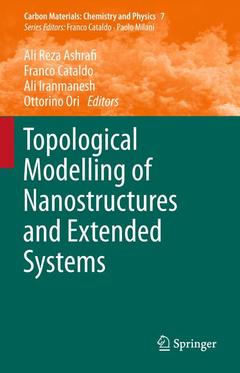Description
Topological Modelling of Nanostructures and Extended Systems, 2013
Carbon Materials: Chemistry and Physics Series, Vol. 7
Coordinators: Ashrafi Ali Reza, Cataldo Franco, Iranmanesh Ali, Ori Ottorino
Language: English
Subjects for Topological Modelling of Nanostructures and Extended Systems:
Publication date: 06-2015
Support: Print on demand
Publication date: 05-2013
575 p. · 15.5x23.5 cm · Hardback
Description
/li>Contents
/li>Biography
/li>Comment
/li>
Topological Modelling of Nanostructures and Extended Systems completes and expands upon the previously published title within this series: The Mathematics and Topology of Fullerenes (Vol. 4, 2011) by gathering the latest research and advances in materials science at nanoscale. It introduces a new speculative area and novel concepts like topochemical reactions and colored reactive topological indices and provides a better understanding of the physical-chemical behaviors of extended systems. Moreover, a charming new family of space-filling fullerenic crystals is here analyzed for the first time.
Particular attention is given to the fundamental influences exercised by long-range connectivity topological mechanisms on the chemical and physical properties of carbon nanostructures. Systems consisting in graphenic layers with structural and topological defects are investigated in their electronic and magnetic behaviors also in presence of metallic particles.
More specifically, the book focuses on:
- Electronic Properties of low dimensional nanostructures including negatively-curved carbon surfaces;
Pariser-Parr-Pople model hamiltonian approach to graphene studies;
- Topochemistry and Toporeactcivity of extended sp2-nanocarbons: PAH, fullerenes, nanoribbons, Moebius-like nanoribbons, nanotubes and grapheme;
- Novel class of crystal networks arising from spanning fullerenes;
- Nanostructures and eigenvectors of matrices and an extended treatise of topological invariants;
- Enumeration hetero-fullerenes by Polya theory.
Topological Modelling of Nanostructures and Extended Systems represents a valuable resource to advances graduates and researchers working in mathematics, chemistry, physics and material science.
Helical Wrapping of Graphene sheets and their Self-assemble into Core-Shelled Composite Nanostructures with metallic particles.- First-Principles Study of the Electronic and Magnetic Properties of Defects in Carbon Nanostructures.- Structural defects on the Electronic Transport Properties of Carbon-based Nanostructures.- Topological versus Physical and Chemical Properties of Negatively Curved Carbon Surfaces.- Topochemistry of spatially extended sp2 nanocarbons: fullerenes, nanotubes, and grapheme.- A Pariser-Parr-Pople Model Hamiltonian based approach to the eletronic structure and optical properties of graphene nanostructures.- Topological invariants of Möbius-like graphenic nanostructures.- Spanning Fullerenes as Units in Crystal Networks.- Introducing „Colored“ Molecular Topology by Reactivity Indices of Electronegativity and Chemical Hardness.- Nanostructures and Eigenvectors of Matrices.- Theoretical analysis of the reactivity of carbon nanotubes: local versus topological effects.- Computation of the Szeged index of some nanotubes and dendrimers.- The Edge-Wiener index and its computation for some nanostructures.- Study of Fullerenes by Some New Topological Index.- Topological Study of (3,6)- and (4,6)-Fullerenes.- Enumeration of Hetero – Molecules by Using Pólya Theorem.
Prof. Dr. Ali Reza Ashrafi, University of Kashan, Department of Mathematics, Kashan, Iran
Prof. Dr. Franco Cataldo, Tor Vergata University, Department of Materials Science, Rome, Italy
Prof. Dr. Ali Iranmanesh, Tarbiat Modares University, Department of Mathematics, Tehran, Iran
Dr. Ottorino Ori, Actinium Chemical Research, Rome, Italy




